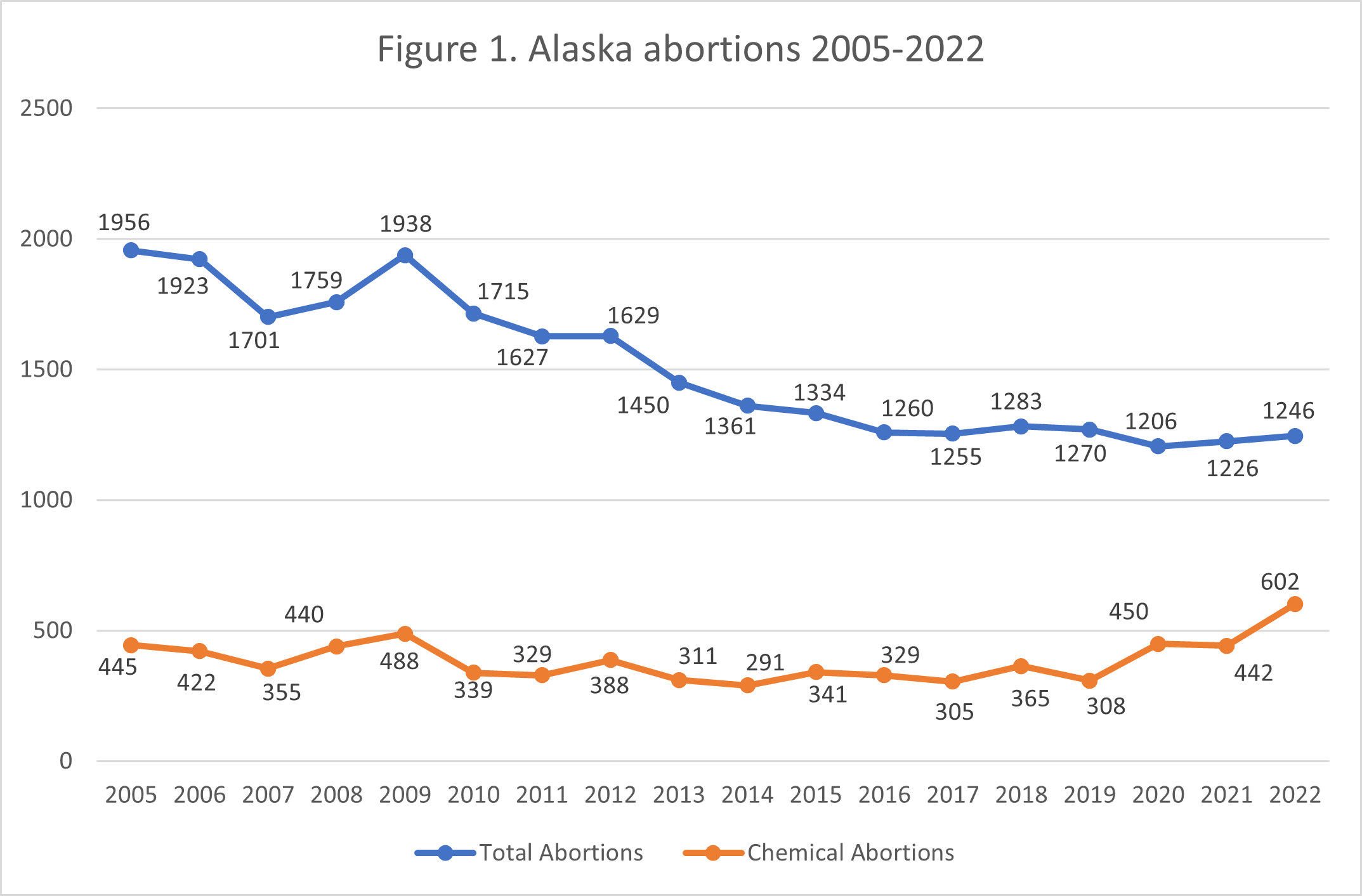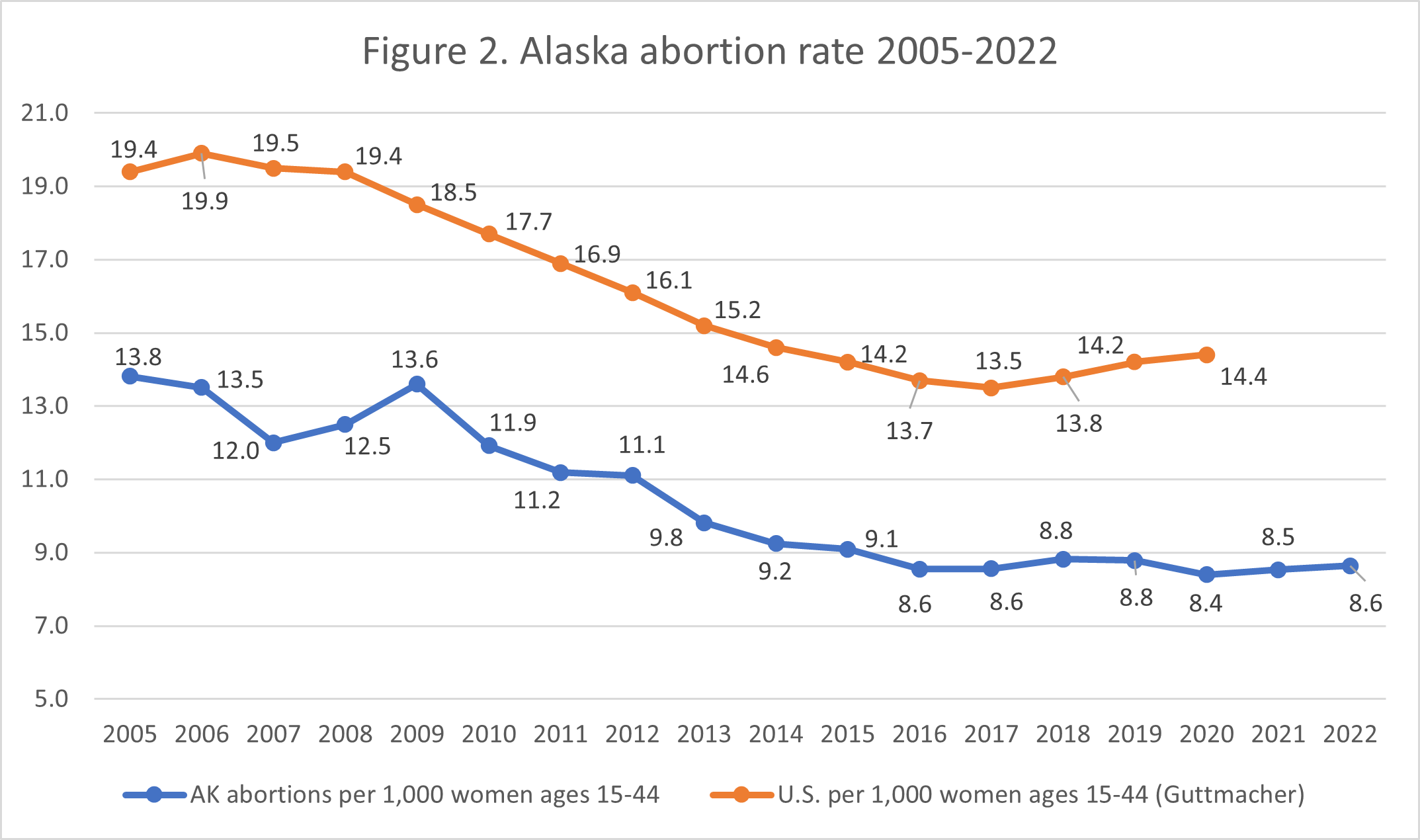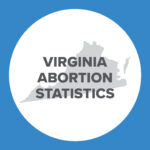Abortion Reporting: Alaska (2022)
Alaska released its 2022 abortion statistics online in February 2023. The report shows that abortions increased from 2021. As of December 2023, 24 states had released 2022 abortion reports, with 14 showing increases in abortion totals from the previous year. In Alaska’s 2022 abortion report, the state’s Department of Health offered slight corrections for the state’s total number of abortions and its chemical abortion total.
Statistics and Changes in Alaska Abortions, 2021-2022

The report does not include information on Planned Parenthood’s abortion market share.
Abortion Totals and Trends
There were 1,246 abortions reported in Alaska in 2022, up not quite 2% from 2021 (Fig. 1). Chemical abortions increased by 36%, making up 48% of the total in 2022. The Charlotte Lozier Institute (CLI) estimates that Alaska’s 2022 abortion rate was 8.6 abortions per 1,000 women ages 15 to 44, an increase of 1% from 2021 (Fig. 2).1
State Report Summary
Alaska’s report cautions that “reported data may include terminations that were medically necessary to save the mother’s life or were not elective (such as ectopic or molar pregnancies) or where medication was provided to manage a miscarriage,” even though Alaska’s Vital Statistics Act’s definition of “induced termination of pregnancy” excludes miscarriage management and ectopic pregnancies.
The vast majority of Alaska abortions (99%) were performed on state residents. Just 15 abortions were performed on women from other states, while the state of residence was not reported for two abortions. Over half the abortions were obtained by women in their twenties, with 31% on women ages 20 to 24 and 26% on women ages 25 to 29. Thirty percent of Alaska abortions were performed on women in their thirties. Ten percent of the abortions were performed on girls ages 19 and younger, and 3% were obtained by women ages 40 or older.
Just under half the abortions, 49%, were obtained by white women. Twenty-four percent were performed on American Indian/Alaska Native women, and 9% each were performed on Asian/Pacific Islander women and black women. Seven percent of the abortions were obtained by women of multiple or other races, while race was not reported for 2% of the abortions. CLI estimates that the black abortion rate in Alaska was 21.9 abortions per 1,000 women ages 15 to 44, three times the white abortion rate of 6.9. Ninety percent of the abortions were on non-Hispanic women and two percent were on Hispanic women, although ethnicity was not reported for 8%.
Most Alaska abortions were performed on women with 12 or more years of education: 69% were performed on women with 12 years of education, and 25% on women with 13 years or more. Five percent of the abortions were obtained by women with fewer than 12 years of education, and less than 1% by women for whom level of education was not reported.
Fifteen percent of Alaska abortions were on married women, and 64% on unmarried women. Marital status was not reported for 22% of Alaska’s abortions in 2022. As it did in its 2021 report, Alaska’s report explained that its marital status data contains a higher-than-average number of unknowns and that the state is working with abortion providers to improve reporting.
Forty-seven percent of the abortions were obtained by women who had no previous live births, compared to just over a fifth of women (21%) with one prior live birth and 32% on women with more than one. Sixty-seven percent of the abortions were performed on women with no prior abortions. Twenty-two percent were performed on women with one previous abortion, and 10% were on women with two or more prior abortions.
Forty-four percent of Alaska abortions were funded by state Medicaid, the same percentage as in 2021. Six percent were covered by insurance, and 34% were self-pay. Sixteen percent were funded through some other means.
In 2022, three abortions were performed because the babies were diagnosed with congenital anomalies. Twenty-one percent of the women undergoing abortion received Alaska’s informed consent materials.
Thirty-three percent of the abortions reported in Alaska occurred at six weeks of gestation or earlier. Forty-two percent were performed between seven and nine weeks, and 18% occurred between 10 and 13 weeks of gestation. Three percent of Alaska abortions were performed between 14 and 15 weeks, and another 3% occurred from 16 to 17 weeks. There were no abortions performed between 18 and 20 weeks of gestation, but one abortion was performed at 21 weeks of gestation or later.
Forty-one percent of reported Alaska abortions were performed using suction curettage, a large decrease from 54% in 2021. The decrease in suction curettage procedures coincided with a major increase in chemical abortions in the state, with chemical abortions making up 48% of the total in 2022. Ten percent of Alaska abortions were dilation and evacuation procedures. There was one prostaglandin abortion and one abortion performed using some other means.
Legislative Changes
Following the overturn of Roe v. Wade in June 2022, Alaska’s abortion law remained unchanged. Abortion is still legal in Alaska without any gestational limitation. Abortion remains legal in Alaska up until the moment of birth because a 1997 Alaska Supreme Court decision (Valley Hosp. Ass’n, Inc. v. Mat-Su Coal. for Choice) determined that Alaska’s state constitution protected abortion as a “fundamental privacy right.”
Following a letter co-signed in early 2023 by Alaska’s Attorney General Treg Taylor along with other attorneys general, stating their official position as being against the abortion industry’s abortion-by-mail scheme, Walgreens announced that it would not dispense dangerous abortion pills in its Alaska locations. However, Alaska does not have a law requiring abortion pills to be dispensed in person, and some online abortion centers advertise that they mail abortion pills into Alaska.
State Ranking
In CLI’s 2016 paper evaluating abortion reporting across the United States, Alaska’s reporting tied for 21st best. Alaska could improve its reporting by ensuring that all abortions occurring in the state are reported, including those induced using abortion pills mailed from out-of-state. Additionally, Alaska could require healthcare providers to report abortion-related complications they treat.


- National rates were calculated by the Guttmacher Institute. Alaska rates were calculated by CLI using the following formula: (total number of abortions performed in Alaska ÷ number of resident women ages 15-44 [based on most recent population estimates]) x 1,000. Rates may differ slightly from previous CLI articles due to revised population estimates. Population estimates were obtained from the CDC WONDER database. Estimates for 2005-2009 are intercensal estimates of the July 1 resident population. Estimates for 2010-2019 are Vintage 2020 postcensal estimates of the July 1 resident population. Estimates for 2020-2022 are Vintage 2022 postcensal estimates of the July 1 resident population. Estimates were produced by the U.S. Census Bureau and the National Center for Health Statistics.



























